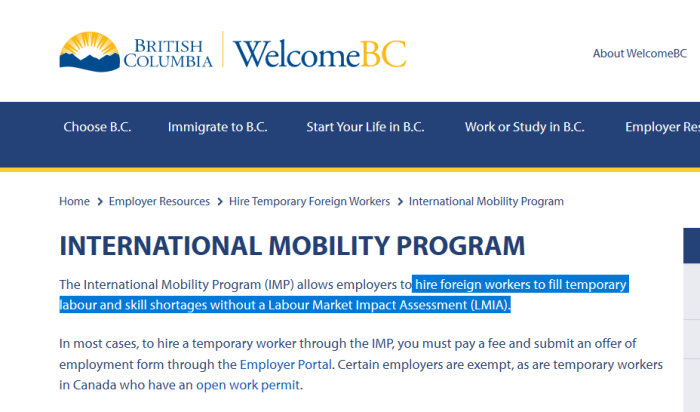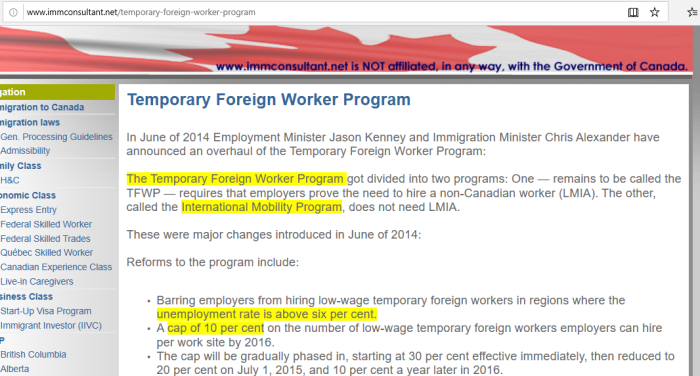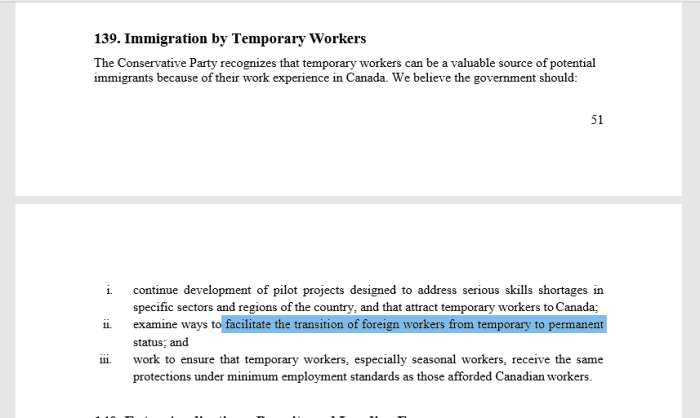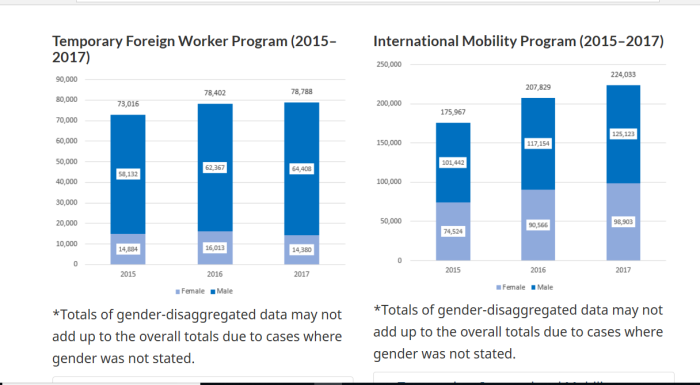(International Mobility Program, essentially an extension of TFWP, but no labour shortages actually are required. Open work permits)

(Information on open work permits)

(From immconsultant.net, on splitting program)

(Conservative Party of Canada policy is to look for ways to transition “temporary” workers into permanent residents, wherever feasible.)

(Source: 2018 Immigration Report to Parliament)


1. Mass LEGAL Immigration In Canada
Despite what many think, LEGAL immigration into Canada is actually a much larger threat than illegal aliens, given the true scale of the replacement that is happening. What was founded as a European (British) colony is becoming unrecognizable due to forced demographic changes. There are also social, economic, environmental and voting changes to consider. See this Canadian series, and the UN programs for more detail. Politicians, the media, and so-called “experts” have no interest in coming clean on this.
CLICK HERE, for UN Genocide Prevention/Punishment Convention.
CLICK HERE, for Barcelona Declaration & Kalergi Plan.
CLICK HERE, for UN Kalergi Plan (population replacement).
CLICK HERE, for UN replacement efforts since 1974.
CLICK HERE, for tracing steps of UN replacement agenda.
Note: If there are errors in calculating the totals, please speak up. Information is of no use to the public if it isn’t accurate.
2. Important Links
(1) https://www.welcomebc.ca/Employer-Resources/Hire-Temporary-Foreign-Workers/International-Mobility-Program
(2) http://archive.is/2u2qD
(3) http://www.cic.gc.ca/english/helpcentre/answer.asp?qnum=176&top=17
(4) http://archive.is/mCkIa
(5) http://www.cic.gc.ca/english/helpcentre/answer.asp?qnum=177&top=17
(6) http://archive.is/YLBfQ
(7) http://immigrationwatchcanada.org/
(8) http://archive.is/kYdyL
(9) http://www.immconsultant.net/temporary-foreign-worker-program
(10) http://archive.is/3GbeX
(11) https://canadaimmigrants.com/international-mobility-program-workers-transitioned-to-permanent-residents/
(12) http://archive.is/U1943
(13) https://www.statcan.gc.ca/eng/blog/cs/transition-to-permanent
(14) http://archive.is/b1tkv
(15) https://cpcassets.conservative.ca/wp-content/uploads/2019/06/03154936/00477c06063465c.pdf
(16) https://www.canada.ca/en/immigration-refugees-citizenship/corporate/publications-manuals/annual-report-parliament-immigration-2018/report.html
(17) http://publications.gc.ca/site/eng/359079/publication.html
3. Context For Int’l Mobility Program
This program is sold to the public as mutual agreements between countries to allow “young people” the opportunity to work in the other country for a period of time. Typically the cut off age if 25-35 years old, but it varies with different countries. Also, the length of time varies between countries, but is typically 1-2 years.
There is a strong case to be made that a period of work and travel is young adulthood (also called a “Gap Year”) gives the person a broader view of the world. It also helps to strengthen bonds between nations. It allows a reasonable period to work and move freely in another land.
What then is the problem?
First there is the issue of remittances. A person working and then leaving will often take a considerable amount of money home with them, or send the money back to their families. That is money not being spent in the host economy.
Second, there is the supply and demand dilemma. Importing more people, even on a temporary basis means extra competition for citizens of that nation. Employers love it, but struggling workers will not.
Third, at least in Canada, and some other nations, these “working holiday” or “youth mobility” or “International Mobility” programs become the basis of permanent immigration into the country. While the benefits may be debated, it seems fair that the debate should be made publicly. After all, this is yet another immigration program. Note: the CPC openly supports such a policy.
4. Let’s Look At The Numbers
Also worth noting, 525,000 people got their citizenship in a 12 month period. This is despite the “backlog”, and only taking ~350,000 people into Canada.
Source: StatsCan population data.
| Year | TFW | Int Mobility | Student |
|---|---|---|---|
| 2015 | 73,016 | 175,967 | 218,147 |
| 2016 | 78,402 | 207,829 | 265,111 |
| 2017 | 78,788 | 224,033 | 317,328 |
To repeat: all with pathway to permanent residence. Yes, not all will stay, but an awful lot will.
5. Splitting International Mobility and TFW
This article, addresses the topic, including the jurisdictions of the new programs.
New Requirements for the International Mobility Program
On June 20, 2014, the Government of Canada announced changes to the Temporary Foreign Worker Program (TFWP), including reorganizing the TFWP into two distinct programs:
(a) TFWP: requires a Labour Market Impact Assessment (LMIA) and is led by Employment and Skills Development Canada (ESDC); and
(b) International Mobility Program: LMIA – exempt and led by Citizenship and Immigration Canada (CIC).
The following fees/regulations for the International Mobility Program came into force on February 21, 2015.
In short, the “Temporary” Foreign Worker Program will still require going through the motions of demonstrating that foreigners have to be hired, as no Canadian is available to fill these jobs.
The International Mobility Program will essentially be an open work permit where a person coming to Canada can work for anyone for a year or 2.
Worth noting, that in both programs, there are options available to extend your stay, and eventually transition into permanent resident.
Also worth noting is that while the number of TFW has declined, the number of Int’l Mobility participants has shot up. A cynic may wonder if this is a way of avoiding having to do labour analyses.
6. Who Is Eligible For Open Permit?
You may be eligible for an open work permit if you:
(a) are an international student who graduated from a designated learning institution and are eligible for the Post-Graduation Work Permit Program
(b) are a student who’s no longer able to meet the costs of your studies (destitute student)
(c) have an employer-specific work permit and are being abused or at risk of being abused in relation to your job in Canada
(d) applied for permanent residence in Canada
(e) are a dependent family member of someone who applied for permanent residence
(f) are the spouse or common-law partner of a skilled worker or international student
(g) are the spouse or common-law partner of an applicant of the Atlantic Immigration Pilot Program
(h) are a refugee, refugee claimant, protected person or their family member
(I) are under an unenforceable removal order
(j) are a temporary resident permit holder
(k) are a young worker participating in special programs
(l) In each of these situations, you must meet additional criteria to be eligible.
Answer a few questions to find out if you’re eligible for an open work permit.
(a) Typically refers to grads from college or university. Remember, there are hundreds of thousands of them every year.
(k) Presumably refers to International Mobility Program
Basically, an awful lot of people. The public is told that immigration is strictly controlled, and that it is skilled professionals who are getting in. Seems that everyone and their cousin is instead.
Students are allowed to work during the summer as much as they want. Even during school weeks they are allowed to work up to 20 hours/week. International Mobility Participants are not required to have any job or schooling set up before they arrive.
7. Why Mislead The Public?
The 2018 Report to Parliament cites at least 950,000 people as coming to Canada (for the year 2017). This is now 2019, and the numbers are almost certainly higher. However, the public is told that is was only about 300K-350K these last few years. Why lie about it?
(Numbers rounded off)
330,000 Permanent Class + refugee
+317,000 Student Visas
+224,000 International Mobility
+79,000 Temporary Foreign Worker
True, not all will stay, but an awful lot of the “temps” will. Whether the: (a) Student Visas; (b) International Mobility Participants; and (c) Temporary Foreign Workers should have a pathway to citizenship is a question worth discussing. Perhaps there are valid reasons for this.
The sticking point, however, is not including these categories in the figures released to the public. Big difference between:
(I) 300K people entering, and
(II) 300K + 600K “temps” entering.
Wouldn’t you agree?
